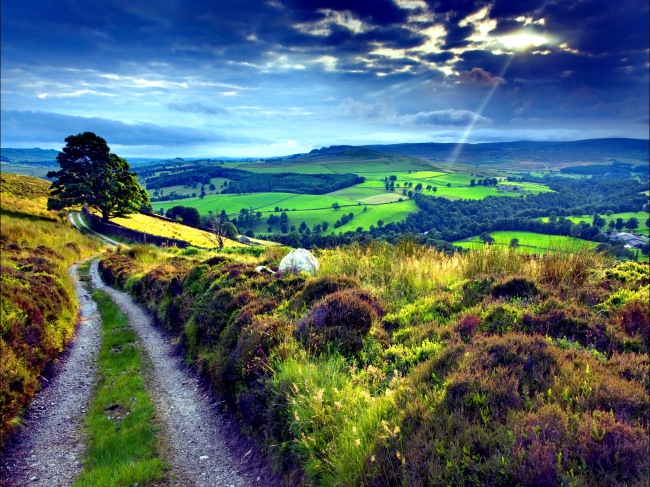
If I do not walk, I cannot make a work of art- Hamish Fulton
The British countryside has for centuries, been a source of inspiration for artists, writers, poets and musicians, and even those who simply want to escape the stresses of every day of life. A road or path can be a quiet companion, it does not judge or ask questions but invites you to clear your mind. Throughout British history country walks through the natural landscapes have provided a haven for Romantics such as Wordsworth, and a comfort for artists such as Constable. Today this view still remains; the countryside can be that oasis in the desert, giving clarity, and soothing the soul. The event differs for each person; its nature is subjective which is what seems to make each walk a work of art in its own way; a stroll down a country lane will no doubt be different to the ramble up the mountains of The Lakes District.
Whilst is can be said that the art of a walk is the experience between man and nature, many would argue that the camaraderie shared with fellow walkers as they make their way together is what makes this popular hobby so special. The satisfaction of reaching the top of a mountain is an extraordinary feeling, as one looks out to the vast scenery around them. There is something truly refreshing about the breathtaking views surrounding you, and the fresh crisp mountain air hitting your lungs. Furthermore this spiritually refreshing moment is certainly unique when experiencing it with friends of a similar mindset. The transcendent beauty of nature can liberate the walker from their problems, often giving them new eyes in seeing a solution. It makes room for new ‘thoughts of more deep seclusion.’
A road or a path does not judge, it does not ask questions or tell you no, it is that silent companion you need to let you self reflect. A walk is a subjective experience, there is no right or wrong way to go, you are the artist, and the walk is your canvas; you decide how long it will last, or which route you want to take. A walk allows for originality and initiative. A walk is what the walker makes it, in the same way that when admiring a canvas; the reactions of the spectator are never the same.
For the great British poet William Wordsworth, there was nothing more invigorating or inspiring than the rural simplicity of the British countryside. To him, the external world hinted at a greater spiritual reality, trying to communicate as one with creation, trees were unique symbols, and rocks and stones had their own hidden language, and mountains mysterious statements. This was the spirit of nature; this was a true work of art. His many poems were the byproduct of nature’s profound effect upon his very being, this ‘sense sublime’ that became his muse, lending him the material to create his meditative and philosophical works. The Lake District where he lived, was charged with a celestial significance, unharmed by machines of modernity, only touched by the tracks of man and his dog hiking the hills and vales absorbing the organic splendor of its meandering valleys and glistening lakes.
The High Line public park in New York City, that has been developed on an historic freight rail line elevated above the streets on Manhattan’s West Side, and was founded to preserve the land from demolition. It runs for 1.45 miles, and has transformed an essential piece of the city’s industrial past, into a place where residents and tourists can escape from the busy streets. What makes this walk a work of art is that whilst strolling along the elevated walkway, one can gaze out to the famous city skyline, viewing it from a different perspective. As the path winds it way through the different neighborhoods of lower Manhattan it follows the diverse architecture of high -rise buildings. This experience itself is perhaps similar to a tour of a modern art gallery, with even the benches that sit along the path, reminding the visitor of a modern day sculpture.
Wordsworth strongly argued that too often is ‘our meddling intellect’ found guilty, in its constant digging for deeper meanings. Yet when walking through the countryside, this relentless need of man to analyze and judge seems to disappear, allowing one to appreciate the wholesome pleasure of their surroundings; ‘how Sweet is the lore which Nature brings’. So frequently today we find ourselves over analyzing the details of our daily lives, scrutinizing our every action. Similarly, works of art are too closely examined, and a painting can become a mundane analysis drained of all its aesthetic beauty. Instead of celebrating the work of art, ‘we misshape the beauteous form of things…we murder to dissect’. Instead he seems to be saying that we should appreciate the pure beauty of something for what it is. Walking encouraged the seeds of his imagination to sprout to life, and it can do the same for us.
Today we so often find ourselves caught up in new technology with our Iphones, Ipads, ipods and laptops, people dont even read real books anymore thanks to the kindle. Perhaps revelling in nature will remind us what pure happiness is, and that in itself for me is art.

